A “massive shortage” of cattle in Canada is providing a silver lining for Cattleland Feedyards amid a threefold increase in shipping costs to Europe and record high input prices, the manager of the industry-leading 25,000-head feedlot has stated.
For the last three years, exceptionally dry conditions have dominated much of western Canada with Alberta – the largest beef-producing province in Canada – continuing to grapple against short- and long-term precipitation deficits and above-normal temperatures.
Cattle numbers in Alberta have seen the largest decline countrywide, sliding from 4.816m in January 2022 to 4.628m in January 2023, according to a Statistics Canada report released earlier this year.
It comes on foot of slowly recovering EU markets for Canadian beef exports after the COVID-19 pandemic, a disruption that “really hurt” Cattleland’s hormone-free EU-certified programme, designed to supply around 5,500kg of fresh beef to Europe every week.
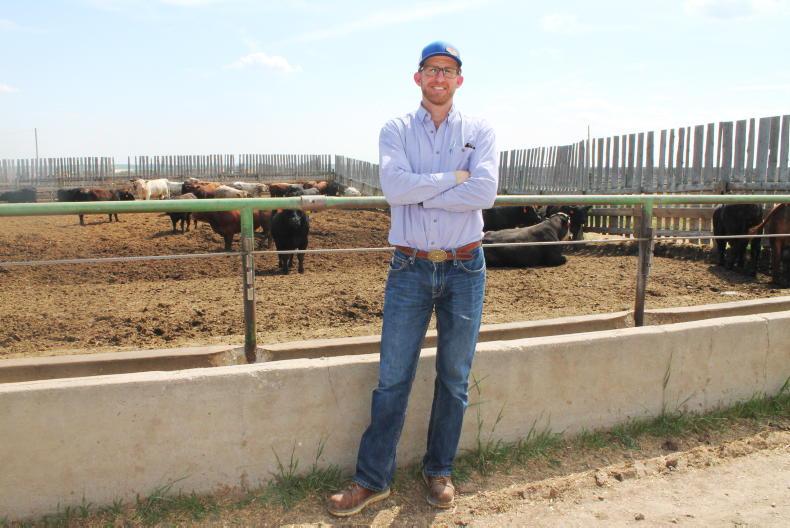
Cattleland Feedyards Ltd research and cattle manager Mick Taylor. \ Claire McCormack
Speaking to the Irish Farmers Journal on a site visit during the International Federation of Agricultural Journalists Congress 2023, Mick Taylor research and cattle manager at Cattleland Feedyards – a feedlot, cow-calf and farming enterprise, and research station – outlined their response to the ongoing dilemma.
“We have a licence for 25,000 head, but right now we’re about half full.
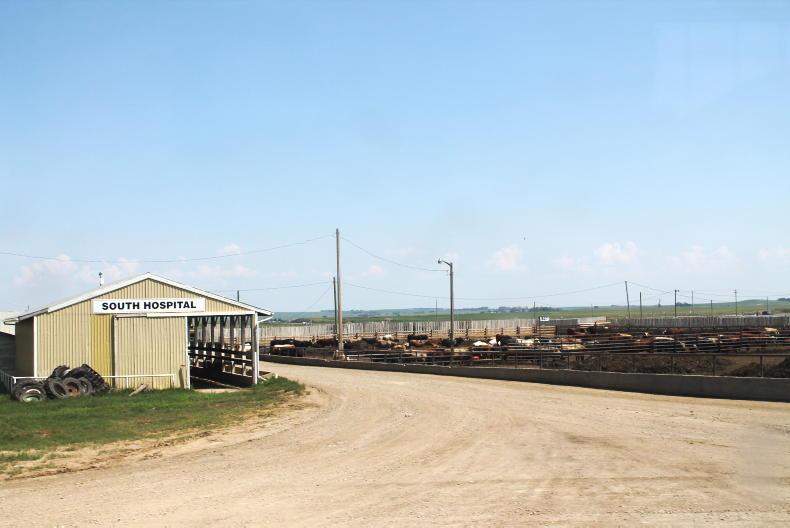
Cattleland Feedyards Ltd near Strathmore, Alberta, Canada. \ Claire McCormack
“We’re getting rid of our calves from last fall now, getting yearlings in bit by bit. This is really our maintenance time to build and fix pens and do farm work before the ground frost comes.
“On top of feeding all those cattle, we farm about 15,000ac between cash crops and silage.
“The last three years of drought have really hurt us in terms of our price in commodities, but also our silage.
“We typically put up about 30,000 metric tonnes of silage. We’ve struggled to get half of that the last couple of years and that’s with 3,500ac of irrigation, so it’s been tough.
“We seeded a lot more this year, hoping we’d get a good silage crop, but we got hail and five inches of rain a few days ago, which smoked a bunch of it out so we’re not having much luck. Every single one of our pivots is under for silage this year.
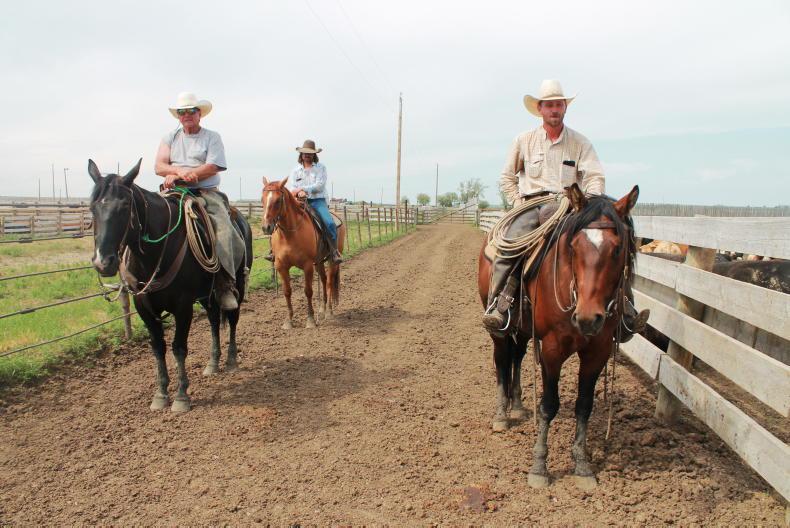
Cattleland Feedyards Ltd cowboys (from left) Reg Achlyk, Travis Klassen and Ryan McKay. \ Claire McCormack
“We also have around 550 cows that we calve out each spring. Unlike most yards, we are EU-certified so from our cow herd we can produce hormone-free beef for the EU under the watchful eye of the Canadian Food Inspection Agency.
“Prior to COVID-19, our volumes fluctuated a little but, at our peak, we were processing on average 40 animals per week – 280-head harvests per month.
“From those animals we were exporting virtually the entire carcase minus the trim. It was the rough equivalent of around 5,500kg of fresh beef per week.
“Our primary market was, and still is, Italy, through our partner Bervini Primo SRL. From Italy, the beef is being distributed throughout Europe.
“Our beef has been sold in 12 different European countries with the major markets outside of Italy being Germany, France and the Netherlands.”
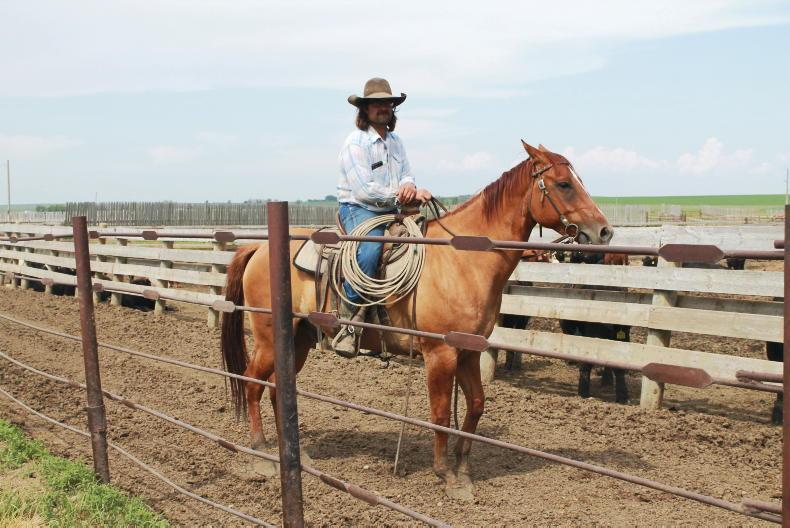
Cattleland Feedyards Ltd cowboy Travis Klassen. \ Claire McCormack
While this route to market had proven “quite profitable” up until 2020, Taylor – originally from Queensland, Australia – said the onset of the pandemic “really hurt” demand as costs skyrocketed too.
“Our primary focus is Europe. We have had interest from Asian countries but have not pursued those opportunities and we do not export anything to the US. Anything that does not go to Europe stays here in Canada.
Freight rates
“Since COVID-19, our freight rates have tripled. We’re supplying a high-end premium product, these cattle are the top of the tops, but the downturn in the restaurant industry in Europe really hurt that. It is picking up bit by bit but it’s slow,” he said.
While the feedlot was typically operating at about a 50:50 ratio of implanted versus hormone-free beef, their stock has now flipped to 90% implanted cattle destined for the home market.
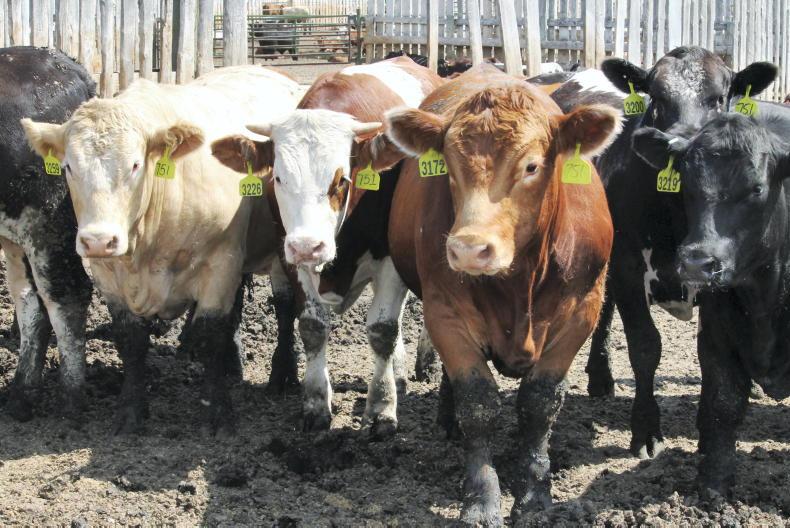
Stock in pens at Cattleland Feedyards. \ Claire McCormack
“As a result of the drought, there has been a massive cattle shortage in Canada. When it gets tough and you’ve got higher feed prices, you tend to get rid of cows that you normally would keep.
“You get rid of more heifers to keep your cashflow going, so you’ve got less replacement breeding cattle in two years’ time. We’re down 2.4% again this year in the national beef cattle herd [around 230,000 head] and less heifers retained.
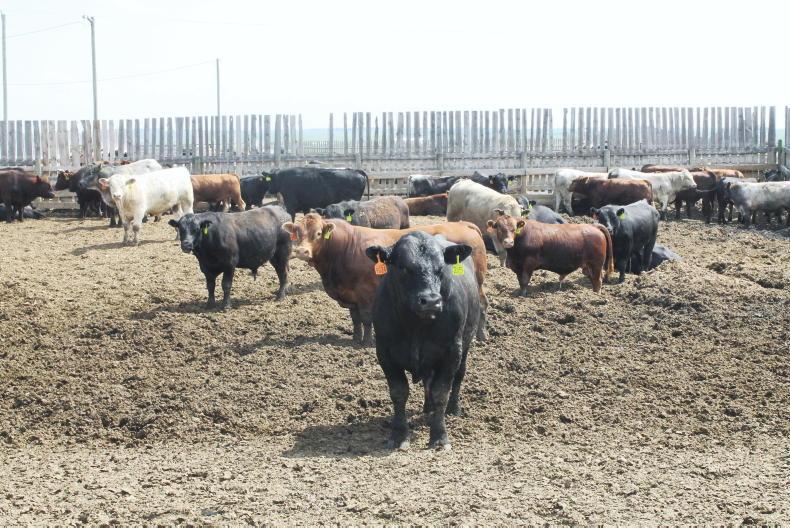
Stock in pens at Cattleland Feedyards. \ Claire McCormack
“But, on the other side, our beef price has gone up, so we can actually make a few dollars right now. It’s just luck for us because we did have a lot of cattle destined for the EU programme.
“The price of our fat cattle domestically is at an all-time high, we’re at $4.10/lb (€6.37/kg) carcase weight, so we can make more money feeding them here.
“When you take the implant out, you lose a lot of efficiency and your cost of gain goes up 15% to 20%. So if we can make dollars here by implanting them and gaining that efficiency, you would need a hell of a premium on the other end to keep them for the EU.”
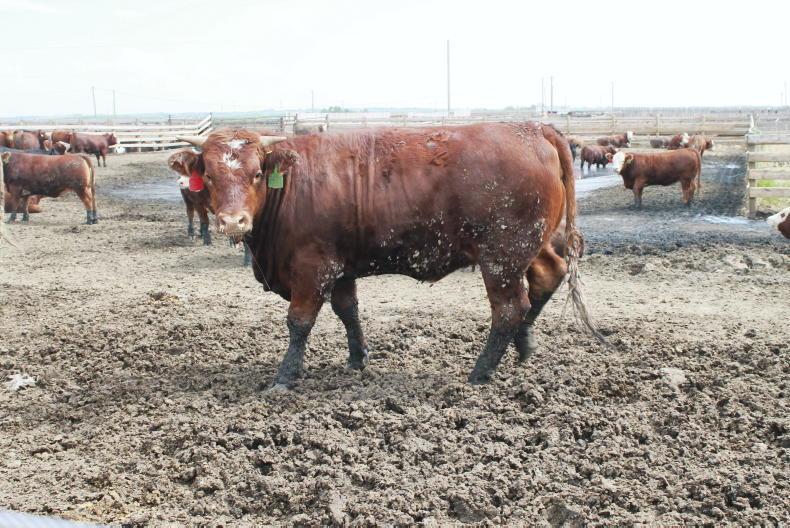
Stock in pens at Cattleland Feedyards. \ Claire McCormack
Demand for hormone-free, antibiotic-free beef
Asked about demand for hormone-free, antibiotic-free beef among Canadian consumers, Taylor said “it’s a very niche market”.
“It’s a small portion of the market. There are particular burger chains promoting hormone-free beef or no added hormones but most of that comes from cull cows because they’re typically never implanted.
“We’ve shipped the odd load of cattle for domestic use but not a huge number. Some people really like the idea of natural but it’s the flavour of the month, these things come and go.
“Just like Beyond Meat, these niches hit their peak and now they’re on their way down for demand in Canada.”
Asked about future plans to refocus on Europe, Taylor said they intend to expand this side of the business when the time in right.
“Our only issue is keeping the price of the product at a level that can sustain growth.
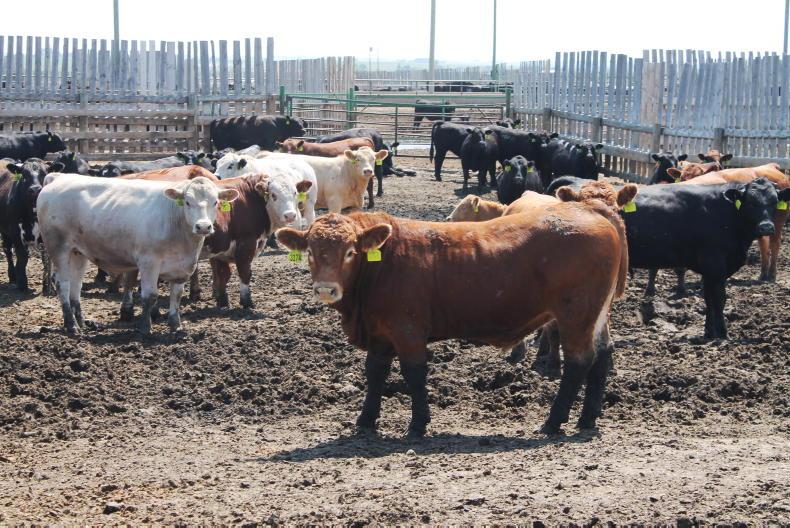
Stock in pens at Cattleland Feedyards. \ Claire McCormack
“Inflation, high cattle costs, high feeding costs and high transportation costs have been a challenge to manage and have limited our ability to grow.
“We hope that over the course of the next year, these high costs will level out and we are able to reach our full potential in the European market.”
Cattleland Feedyards take in cattle from 600lb (272kg) calves and take them all the way to slaughter. They transition through five different rations from high roughage (around 70% silage and 20% dry rolled barley), to a finishing ration of 87% rolled barley. Barley prices are also at a record high in Canada at about $450/t (€317/t). Animals are slaughtered from 12 to 24 months with most cattle on site less than 30 months of age. The cattle are shipped to two packing plants within the province.
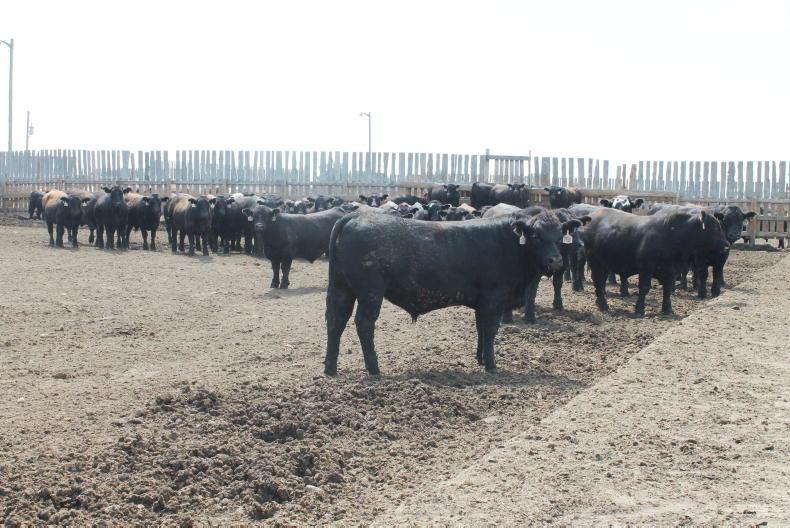
Angus cattle at Cattleland Feedyards. \ Claire McCormack
At least 50% of the stock have Angus genetics. While they don’t currently buy dairy-cross calves, this is considered an increasing market in Canada too.
The company is increasingly buying ranch-direct cattle, with around 70% coming from online auctions. The aim here is to minimise third-party handling and reduce stress on the cattle, added Taylor.
In terms of slurry management, every spring all of the manure leaves the site on trucks to be spread as fertiliser on the fields of the company’s Creekstone Farms.
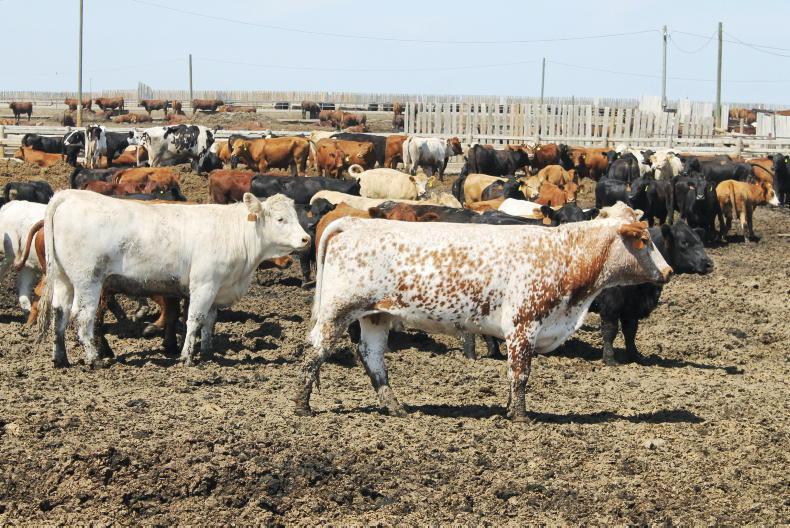
Stock at Cattleland Feedyards. \ Claire McCormack
“These days, with urea prices as high as they are globally, our phone rings off the hook with farm neighbours wanting our manure. It’s a luxury for them than buying urea, synthetic fertiliser,” he said.
Key research studies conducted at Cattleland’s in-house integrated beef research station relate to implant trials with a focus on food safety and economic viability, plus animal and calf welfare studies. Research on lowering emissions from cattle feed is yet to be examined at the facility.
Each week consulting nutritionists test feed samples, inspect pens and take water samples on site.
“It’s just like a personal trainer for a human. They are making sure that we are sticking to their protocol and, more importantly, if we have troubles or mistakes they are the first call.
“Social media has created this misconception that we’re bad in this industry but we have a governing body on us watching everything we do.
“We pay vets a fortune to make sure animal health is good, we pay consulting nutritionists a fortune to make sure they are fed right. Like any animal, they are not going to perform unless you treat them incredibly well and if they don’t perform, we will be out of business.”
A “massive shortage” of cattle in Canada is providing a silver lining for Cattleland Feedyards amid a threefold increase in shipping costs to Europe and record high input prices, the manager of the industry-leading 25,000-head feedlot has stated.
For the last three years, exceptionally dry conditions have dominated much of western Canada with Alberta – the largest beef-producing province in Canada – continuing to grapple against short- and long-term precipitation deficits and above-normal temperatures.
Cattle numbers in Alberta have seen the largest decline countrywide, sliding from 4.816m in January 2022 to 4.628m in January 2023, according to a Statistics Canada report released earlier this year.
It comes on foot of slowly recovering EU markets for Canadian beef exports after the COVID-19 pandemic, a disruption that “really hurt” Cattleland’s hormone-free EU-certified programme, designed to supply around 5,500kg of fresh beef to Europe every week.

Cattleland Feedyards Ltd research and cattle manager Mick Taylor. \ Claire McCormack
Speaking to the Irish Farmers Journal on a site visit during the International Federation of Agricultural Journalists Congress 2023, Mick Taylor research and cattle manager at Cattleland Feedyards – a feedlot, cow-calf and farming enterprise, and research station – outlined their response to the ongoing dilemma.
“We have a licence for 25,000 head, but right now we’re about half full.

Cattleland Feedyards Ltd near Strathmore, Alberta, Canada. \ Claire McCormack
“We’re getting rid of our calves from last fall now, getting yearlings in bit by bit. This is really our maintenance time to build and fix pens and do farm work before the ground frost comes.
“On top of feeding all those cattle, we farm about 15,000ac between cash crops and silage.
“The last three years of drought have really hurt us in terms of our price in commodities, but also our silage.
“We typically put up about 30,000 metric tonnes of silage. We’ve struggled to get half of that the last couple of years and that’s with 3,500ac of irrigation, so it’s been tough.
“We seeded a lot more this year, hoping we’d get a good silage crop, but we got hail and five inches of rain a few days ago, which smoked a bunch of it out so we’re not having much luck. Every single one of our pivots is under for silage this year.

Cattleland Feedyards Ltd cowboys (from left) Reg Achlyk, Travis Klassen and Ryan McKay. \ Claire McCormack
“We also have around 550 cows that we calve out each spring. Unlike most yards, we are EU-certified so from our cow herd we can produce hormone-free beef for the EU under the watchful eye of the Canadian Food Inspection Agency.
“Prior to COVID-19, our volumes fluctuated a little but, at our peak, we were processing on average 40 animals per week – 280-head harvests per month.
“From those animals we were exporting virtually the entire carcase minus the trim. It was the rough equivalent of around 5,500kg of fresh beef per week.
“Our primary market was, and still is, Italy, through our partner Bervini Primo SRL. From Italy, the beef is being distributed throughout Europe.
“Our beef has been sold in 12 different European countries with the major markets outside of Italy being Germany, France and the Netherlands.”

Cattleland Feedyards Ltd cowboy Travis Klassen. \ Claire McCormack
While this route to market had proven “quite profitable” up until 2020, Taylor – originally from Queensland, Australia – said the onset of the pandemic “really hurt” demand as costs skyrocketed too.
“Our primary focus is Europe. We have had interest from Asian countries but have not pursued those opportunities and we do not export anything to the US. Anything that does not go to Europe stays here in Canada.
Freight rates
“Since COVID-19, our freight rates have tripled. We’re supplying a high-end premium product, these cattle are the top of the tops, but the downturn in the restaurant industry in Europe really hurt that. It is picking up bit by bit but it’s slow,” he said.
While the feedlot was typically operating at about a 50:50 ratio of implanted versus hormone-free beef, their stock has now flipped to 90% implanted cattle destined for the home market.

Stock in pens at Cattleland Feedyards. \ Claire McCormack
“As a result of the drought, there has been a massive cattle shortage in Canada. When it gets tough and you’ve got higher feed prices, you tend to get rid of cows that you normally would keep.
“You get rid of more heifers to keep your cashflow going, so you’ve got less replacement breeding cattle in two years’ time. We’re down 2.4% again this year in the national beef cattle herd [around 230,000 head] and less heifers retained.

Stock in pens at Cattleland Feedyards. \ Claire McCormack
“But, on the other side, our beef price has gone up, so we can actually make a few dollars right now. It’s just luck for us because we did have a lot of cattle destined for the EU programme.
“The price of our fat cattle domestically is at an all-time high, we’re at $4.10/lb (€6.37/kg) carcase weight, so we can make more money feeding them here.
“When you take the implant out, you lose a lot of efficiency and your cost of gain goes up 15% to 20%. So if we can make dollars here by implanting them and gaining that efficiency, you would need a hell of a premium on the other end to keep them for the EU.”

Stock in pens at Cattleland Feedyards. \ Claire McCormack
Demand for hormone-free, antibiotic-free beef
Asked about demand for hormone-free, antibiotic-free beef among Canadian consumers, Taylor said “it’s a very niche market”.
“It’s a small portion of the market. There are particular burger chains promoting hormone-free beef or no added hormones but most of that comes from cull cows because they’re typically never implanted.
“We’ve shipped the odd load of cattle for domestic use but not a huge number. Some people really like the idea of natural but it’s the flavour of the month, these things come and go.
“Just like Beyond Meat, these niches hit their peak and now they’re on their way down for demand in Canada.”
Asked about future plans to refocus on Europe, Taylor said they intend to expand this side of the business when the time in right.
“Our only issue is keeping the price of the product at a level that can sustain growth.

Stock in pens at Cattleland Feedyards. \ Claire McCormack
“Inflation, high cattle costs, high feeding costs and high transportation costs have been a challenge to manage and have limited our ability to grow.
“We hope that over the course of the next year, these high costs will level out and we are able to reach our full potential in the European market.”
Cattleland Feedyards take in cattle from 600lb (272kg) calves and take them all the way to slaughter. They transition through five different rations from high roughage (around 70% silage and 20% dry rolled barley), to a finishing ration of 87% rolled barley. Barley prices are also at a record high in Canada at about $450/t (€317/t). Animals are slaughtered from 12 to 24 months with most cattle on site less than 30 months of age. The cattle are shipped to two packing plants within the province.

Angus cattle at Cattleland Feedyards. \ Claire McCormack
At least 50% of the stock have Angus genetics. While they don’t currently buy dairy-cross calves, this is considered an increasing market in Canada too.
The company is increasingly buying ranch-direct cattle, with around 70% coming from online auctions. The aim here is to minimise third-party handling and reduce stress on the cattle, added Taylor.
In terms of slurry management, every spring all of the manure leaves the site on trucks to be spread as fertiliser on the fields of the company’s Creekstone Farms.

Stock at Cattleland Feedyards. \ Claire McCormack
“These days, with urea prices as high as they are globally, our phone rings off the hook with farm neighbours wanting our manure. It’s a luxury for them than buying urea, synthetic fertiliser,” he said.
Key research studies conducted at Cattleland’s in-house integrated beef research station relate to implant trials with a focus on food safety and economic viability, plus animal and calf welfare studies. Research on lowering emissions from cattle feed is yet to be examined at the facility.
Each week consulting nutritionists test feed samples, inspect pens and take water samples on site.
“It’s just like a personal trainer for a human. They are making sure that we are sticking to their protocol and, more importantly, if we have troubles or mistakes they are the first call.
“Social media has created this misconception that we’re bad in this industry but we have a governing body on us watching everything we do.
“We pay vets a fortune to make sure animal health is good, we pay consulting nutritionists a fortune to make sure they are fed right. Like any animal, they are not going to perform unless you treat them incredibly well and if they don’t perform, we will be out of business.”















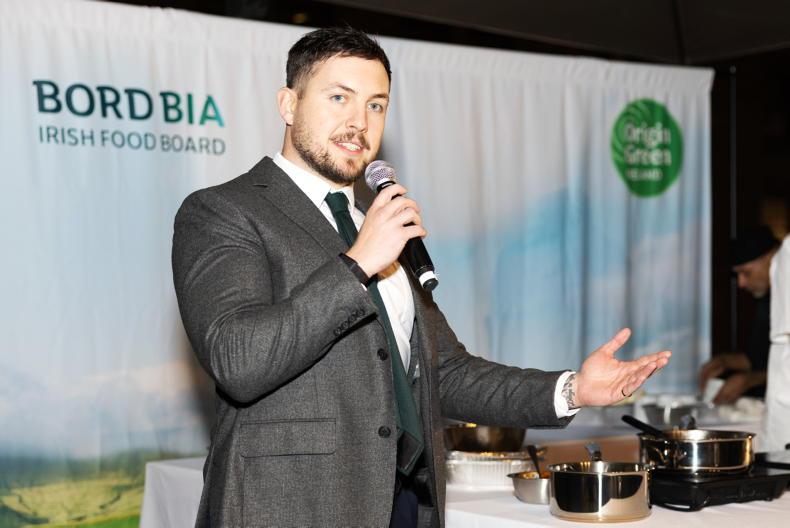
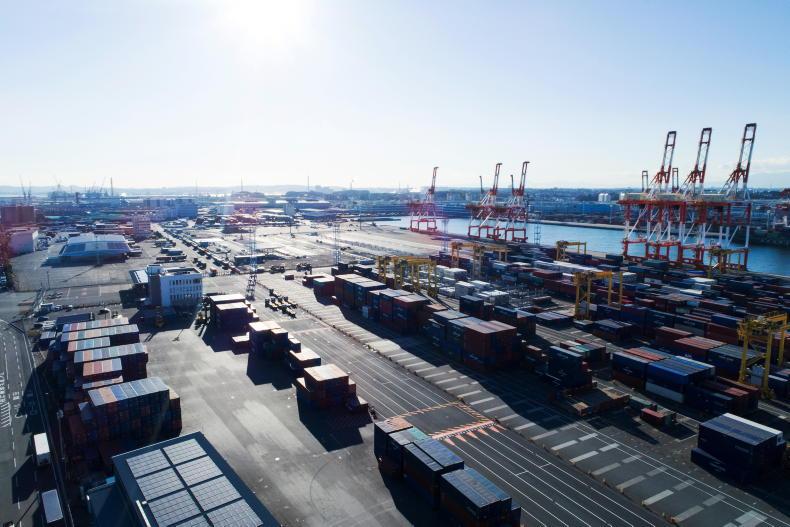
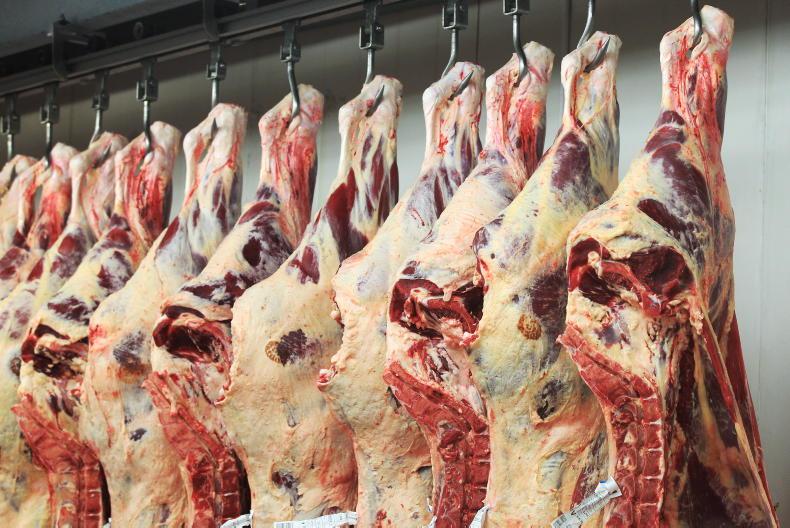
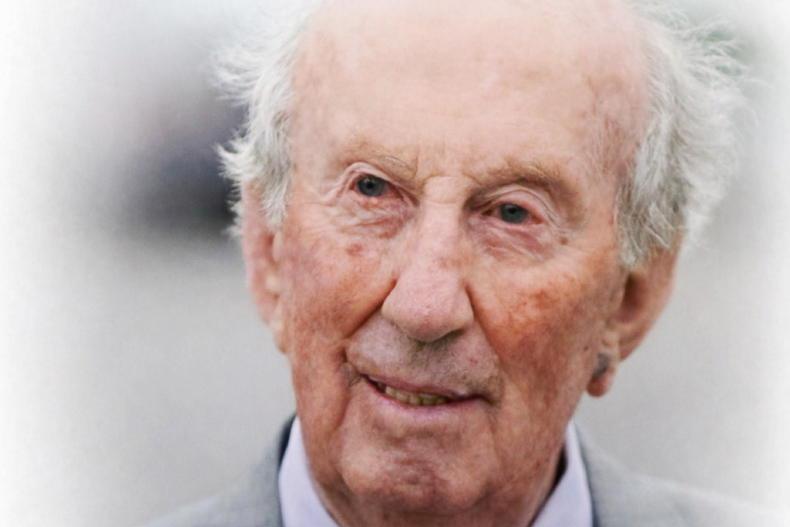
SHARING OPTIONS